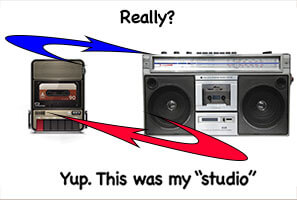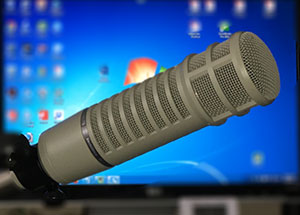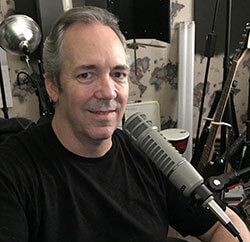Aurora is a premium, all-purpose studio condenser microphone which features an unhyped and natural frequency response, high sensitivity and low self noise. As what the founder Matt McGlynn said the mic was built for recording engineers looking for an ultra-clean FET sound. For more details, check it out here.
Archives for April 2016
The Evolution Of Music Making Technology and Tools
 I started recording myself playing music before people had computers in their homes (with the exception of a few friends whose parents bought them an Apple 2 – not that I am bitter:)). Being a teenager and unable to afford to go to a commercial studio, I recorded multitrack stuff (me singing along with the other me that was playing guitar and yet another version of me singing another part, etc.) with my brother’s “boom box” cassette player and a business cassette recorder I found in my parent’s garage. I can’t even imagine how things would have been if today’s technology existed back then. I would never have left my room, though, I can tell you. Perhaps it wouldn’t have been so good for me:-P.
I started recording myself playing music before people had computers in their homes (with the exception of a few friends whose parents bought them an Apple 2 – not that I am bitter:)). Being a teenager and unable to afford to go to a commercial studio, I recorded multitrack stuff (me singing along with the other me that was playing guitar and yet another version of me singing another part, etc.) with my brother’s “boom box” cassette player and a business cassette recorder I found in my parent’s garage. I can’t even imagine how things would have been if today’s technology existed back then. I would never have left my room, though, I can tell you. Perhaps it wouldn’t have been so good for me:-P.
Anyway – The Music Education Department at The University of Florida has developed a fascinating infographic on the Evolution of Musical Tools that is directly relevant to this constant “what if” game I play with myself about the unbelievable recording and music making tools available today – and available so anyone can afford them, even poor teenaged musicians with questionable social skills:). Take a look below and think for a minute how fortunate you are to live in this day and age. And get off my lawn!:) (just kidding):

A Comparison – Compressor Shootout
Well, this is mainly a comparison of different compressor, BUT with a twist! Watch the video from the REAPER blog and see if you can tell the difference!
Sound Mob Introduced by Akai
Introducing Sound Mob by Akai Pro & MVP loops. It is an expansion pack for MPC and iMPC Pro. Find more about it here.
Review Of The EV RE20 Dynamic Microphone
This is an incredible mic for anyone doing voice-over work, podcasts, or any kind of broadcasting. It’s famous for broadcast use, found in radio stations around the world. Its sound quality is amazing and its resistance to recording p-pops is a huge time saver if you are recording vocals. The mic is also excellent for kick drum or acoustic guitar recording. My Star Rating –

Here is my review of the EV RE20 mic. It is now my go-to vocal mic. So that’s sort of a spoiler about what I think of this fabulous :-).
So I just finished testing out the Electro-Voice RE20 Dynamic Microphone, another fabulous vocal mic that I’ve been wanting to get my hands on for a long time. The other large diaphragm dynamic was the Shure SM7B, which I reviewed last week).
Like the SM7, the EV RE20 is an end-address (you talk into the end and not the side, as with most large diaphragm condensers) dynamic mic found most often in use by radio DJs and other broadcasters. Also like the SM7B, the EV RE20 has a “cardioid” pickup pattern, which means it is most sensitive to what is directly in front of it, while rejecting sound from the rear. If you want to review mic pickup patterns, see my article Directional and Omnidirectional Microphones – What Are They Good For?
Why A Dynamic Mic For Vocals?
[Ken explains – in probably a few more paragraphs than necessary – the answer to the above question. If you don’t care, and would rather just skip to the stuff about how the mic sounded, click here:)]
Yes, typically you’d be told to use a large diaphragm condenser microphone (LDC) for vocal recording. That’s because those mics are super sensitive and can pick up the nuances of a voice really well. Also, compared to your average dynamic microphones like the standard computer mics, headsets and ice-cream cone shaped mics you see on stage for live performances, you can get better vocal quality in a recording at a really decent price. Entry-level LDCs often cost under 100 bucks.
 For studio recording, dynamic mics are normally used only for things like drums or loud electric guitar amps. Dynamic mics are generally less sensitive than condenser mics. And while there are exceptions of course, vocals are almost never recorded in the studio with dynamic mics. Condenser mics are widely regarded as the mics of choice of the voice recording world.
For studio recording, dynamic mics are normally used only for things like drums or loud electric guitar amps. Dynamic mics are generally less sensitive than condenser mics. And while there are exceptions of course, vocals are almost never recorded in the studio with dynamic mics. Condenser mics are widely regarded as the mics of choice of the voice recording world.
Dynamic Mics For Recording Vocals?
However, because LDCs are so sensitive, they are infamous for being TOO sensitive to plosive sounds – the little blasts of air that come out of our mouths when we say words with Ps (and sometimes Bs) in them. This results in unpleasant low-frequency/bassy “splats” in the recording. We usually call these “p-pops.”
This makes it basically mandatory to use something called a pop-filter or a pop screen when recording vocals with an LDC mic. These are those round things with fabric (typically) stretched around them – sometimes they’re made of metal – that are placed between the mouth and the microphone. Pop filters help to prevent p-pops, but they do not eliminate them for most people. Personally, I end up having to edit out every plosive I utter in a vocal recording – even when I DO use a pop filter – which can take a really long time.
Dynamic mics, on the other hand, are often less sensitive. So they are also better at preventing p-pops from getting onto your vocal recordings. The problem is that most dynamic mis just don’t sound as good when recording in the studio. But there ARE some dynamic mics that DO sound great on vocals. They just aren’t quite as affordable as a lot of decent LDCs. The kinds of dynamic mics I’m talking about are the ones typically used by radio DJs and other broadcasters. The Electro-Voice RE20 dynamic microphone is one of those.
So How Did It Sound?
One word – Awesome. I said the Shure SM7B (another broadcast quality dynamic mic) sounded great on my voice. And it does. But the RE20 sounds better. I was pleasantly surprised. But here is the best part. Even without a pop filter, the p-pop/plosive problem was almost non-existent! That was my one quibble with the SM7B. Though it was not as sensitive to plosives as my Rode NT2-A (an LDC mic), there were still quite a lot of p-pops with the SM7. But the RE20 really shines in this very specific, but very important matter. In the RE20 audio recording below, there were a couple of p-pops still. I recorded all samples with my mouth 3 inches away from the mic so they could be fairly compared. But when I backed my mouth away just another inch or two, the p-pops were gone.
The lack of p-pops in the RE20 recordings means saving a ton of time when producing any vocal recording, since I won’t have to painstakingly scrub through and edit just about every word with a “P” in it. Given the amount of time I normally spend doing plosive-hunting, this is a real game changer for me!
Take A Listen To The Audio Samples
Whether one mic “sounds better” than another can often be quite subjective. And truth be told, a mic that sounds fabulous on one person’s voice can sound bad on someone else’s voice. And honestly, all three of these mics are very good!
So with that in mind – after listening to my voice in the RE20, and then comparing the audio of the same text recorded with 2 other mics (my usual Rode NT2-A and the Shure SM7B), I felt that my voice sounded better with the RE20. But for a sanity check, I asked my wife – the lovely and talented Lisa Theriot – to come up and do a “blind” (deaf?) listening test. She ranked them the same way I did: the RE20 sounded best, the SM7B was 2nd place, and the Rode NT2-A was third place.
Have a listen to the samples below. I highly recommend using headphones to hear the subtleties. Also, none of the recordings were edited for p-pops.
First is the Rode NT2-A on “cardioid” setting WITH a pop filter (the sE Electronics meta l pop filter).
Audio PlayerThe next sample is of the excellent Shure SM7B wearing it’s foam windscreen, but without an extra pop-filter:
Audio PlayerAnd finally we have below the recording made with the RE20. There was no pop filter of any kind used on this recording:
Audio PlayerThat Was The Good – Was There Any Bad?
My only quibbles are so minor as to be negligible. But I thought I should mention them. First, the RE20 comes with no manual. In the box is only a sheet with features and specs and the standard warranty paperwork. Now you may wonder why anyone would need a manual for a mic.
Well for starters, it would be nice to know about the bass roll off feature. The is a switch at the bottom of the mic that has a horizontal line on one side and a 45-degree angled line on the other. I can GUESS that this is a bass roll-off feature. But what frequency is used to start the roll off?
Eventually I found it mentioned in the extremely fine print under the “Architects’ and Engineers’ Specifications” section. It read: “when the filter switch is in the “on” position, low frequency response shall tilt down 4.5 dB from 400 to 100 Hz.” That information should have been much easier to find.
My other quibble is that the mic came only with a plastic mic stand clip. That isn’t all that uncommon, but compared to the SM7B’s built-in bracket mount that buffers the mic from vibrations in the stand, it was a bit disappointing.
It actually became a problem when, out of habit, I connected the mic to my desk-mounted boom stand. I did a few recordings that seemed to have a bit too much bass in them. Then I realized that without a “shock mount” every vibration on my desk was traveling right up the mic stand and into the mic. My desk had essentially become part of the mic.
So I moved the mic to a standard mic stand that sat on the carpeted floor, and things became MUCH better. Since the RE20 is so often depicted hanging from desk mounted boom stands in radio stations, it’s important to know that you need the 309A suspension shock mount, which you must buy separately, if you plan to mount it this way.
Specs And Other Good-To-Know Stuff
You can view the really detailed specs on the Electro-Voice site. But here are the highlights.
- It’s a “true cardioid with no coloration at 180-degrees off-axis.” This means that even if you angle the mic partially away from the source, you’ll get the same sound as if you pointed the mic straight at it. This is GREAT news for vocalists, who can reduce any risk of p-pops and even harsh “S” sounds, just by speaking/singing into the mic at a slight angle.
- The frequency response is 45 – 18,000 Hz.
- It’s “variable-D.” Yeah, I didn’t know what that meant either. In a nutshell, it means there is no proximity effect, which is amazing for a “cardioid” mic. With most cardioids, the closer your mouth (or whatever audio source) gets to the mic, the “bassier” (more low frequencies) the audio sounds. And since it’s bass that causes p-pops, the lack of proximity effect means you can get your mouth close to the RE20 without the bass frequencies getting hyped.
- Though the RE20 is described and known as a “broadcast announcer” microphone, it can sound great in other situations as well. The Features sheet mentions that it shines on instruments, specifically acoustic guitar, and as a kick drum mic.
Final Word
I want one. Okay, that’s tree words. Whatever:). In fact I am going to buy one for a Spring present. That’s a thing, right?:-P. Seriously, as much voice-over and singing recording as I do, the superior sound combined with the rejection of ambient noise and p-pops make this mic almost a necessity! At least that’s what I’m telling the lovely and talented Lisa Theriot:-). UPDATE: I did that. The RE20 is my daily mic now.
To get your very own Electro-Voice RE20, CLICK HERE.
I won’t tell:).